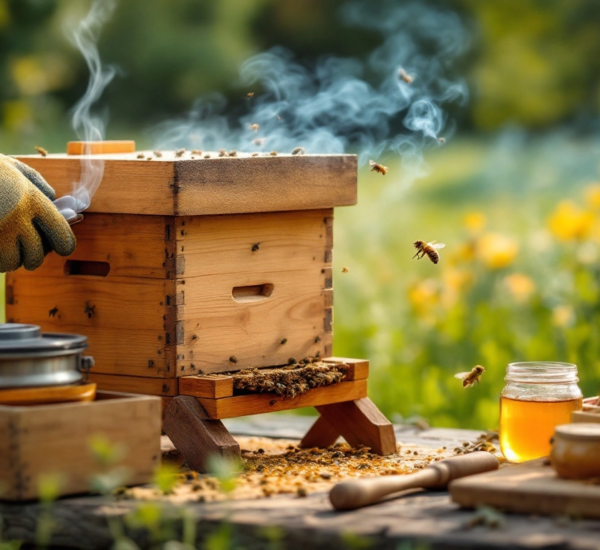Imagine a world where beekeeping not only nourishes thriving honeybee colonies but also supports the environment and local ecosystems. Natural beekeeping techniques offer a holistic and eco-friendly approach to maintaining healthy bees while producing sustainable honey. By prioritizing the bees’ well-being over profit-driven practices, this philosophy is rapidly gaining traction among environmentally conscious beekeepers. Through this guide, you’ll discover the essentials of natural beekeeping, from its core principles and techniques to the must-have supplies and resources for getting started. Whether you’re a beginner or experienced beekeeper, embracing natural methods can revolutionize your approach and benefit both your bees and the planet.
Table of Contents
- What is Natural Beekeeping?
- The Core Principles of Natural Beekeeping
- Key Benefits of Adopting Natural Beekeeping
- Essential Supplies for Natural Beekeeping
- How to Get Started: Courses and Resources
What is Natural Beekeeping?
Defining Natural Beekeeping
At its core, natural beekeeping revolves around working with, rather than against, the natural instincts and behaviors of honeybees. Unlike conventional practices focused on maximizing honey yields, natural beekeeping prioritizes the health and well-being of bees. This philosophy emphasizes minimal intervention, natural hive design, and fostering a self-sustaining colony environment that closely mimics the bees’ natural habitat.
Natural Beekeeping Techniques in Practice
Practicing natural beekeeping techniques involves methods like using top-bar hives or Warré hives instead of heavy, industrial-style Langstroth hives. These hive types are designed to accommodate natural comb building, creating a stress-free environment for bees. Additionally, natural beekeepers avoid practices like artificial feeding, routine use of pesticides, or frequent hive inspections, helping bees thrive with minimal stress. Interested in starting out? Be sure to check out practical beginner tips in this introductory guide to beekeeping.
The Core Principles of Natural Beekeeping
Prioritizing Bee Health Over Honey Harvesting
One of the fundamental tenets of natural beekeeping is focusing on bee health rather than honey production. In this approach, bees are allowed to keep much of the honey they produce to sustain the colony during winter months. This method reduces the need for artificial feeding with sugar syrups, which can be detrimental to their health.
Sustainable Habitat Management
Nurturing a sustainable environment for bees is another critical principle. This involves planting native flowers and diverse pollen sources that align with the ecological needs of the bees. Natural beekeepers also avoid harmful pesticides in favor of organic alternatives, ensuring both the bees and their foraging environments remain safe and healthy. Curious about organic practices? Check out these sustainable insights.
Key Benefits of Adopting Natural Beekeeping
Environmental Benefits
By enhancing biodiversity and promoting natural pollination, natural beekeeping techniques have a profound environmental impact. Healthy bee populations contribute to the growth of plants, trees, and crops that rely on pollination, fostering a mutually beneficial relationship that supports ecosystems worldwide. Additionally, this approach minimizes environmental degradation caused by chemical inputs commonly used in industrial beekeeping.
Benefits for the Beekeeper
As a beekeeper, shifting to natural beekeeping often means reduced costs. By relying on natural materials and avoiding unnecessary treatments or interventions, you’ll spend less on artificial supplies. Moreover, healthier bees tend to be more productive in the long term, ensuring sustainable honey production without compromising the colony’s health. To learn more about bees’ impact on ecosystems, visit our in-depth article here.
Essential Supplies for Natural Beekeeping
Choosing a Sustainable Beekeeping Hive
Investing in the right hive is key to successful natural beekeeping. Popular sustainable options include Warré hives, which replicate tree hollows and promote natural comb building, and top-bar hives, which are easier to inspect while allowing bees to construct combs naturally. These designs minimize stress for the bees and align with their natural instincts.
Natural Beekeeping Tools and Accessories
Equipping yourself with eco-friendly tools is equally important. Essential items include smokers made from natural materials, protective bee suits, and organic treatments for managing pests like Varroa mites. Always source supplies from ethical vendors committed to sustainability, like those recommended in this guide to top apiary tools.
How to Get Started: Courses and Resources
Natural Beekeeping Courses for Beginners
Whether you prefer online learning or hands-on workshops, several courses can help you embrace the natural beekeeping philosophy. Renowned platforms like The Organic Beekeeping Academy offer virtual courses, while local associations often run practical sessions tailored for beginners. Engaging with these resources equips you with actionable skills and the confidence to start your journey.
Recommended Reading and Communities
Books like “The Thinking Beekeeper” by Christy Hemenway provide essential insights into natural beekeeping techniques. Additionally, joining online forums or local beekeeping groups fosters a sense of community and offers invaluable advice from seasoned natural beekeepers.
Frequently Asked Questions
What is the main difference between natural beekeeping and conventional beekeeping?
Natural beekeeping emphasizes minimal intervention and prioritizes the health of bees, while conventional beekeeping often focuses on maximizing honey yields through mechanical or chemical methods.
What are the essential supplies needed for natural beekeeping?
Key supplies include eco-friendly hives like Warré or top-bar hives, natural treatments, sustainable smokers, and ethically sourced protective gear.
Are there any good natural beekeeping courses available online?
Yes, platforms like The Organic Beekeeping Academy and local workshops offer beginner-friendly courses that teach essential natural beekeeping techniques.
How does natural beekeeping benefit the environment?
Natural methods enhance biodiversity, protect pollinators, and reduce the environmental impact of harmful chemicals used in traditional practices.
Can I shift from conventional to natural beekeeping easily?
Yes. Transitioning involves gradually adopting practices like switching hives, eliminating pesticides, and learning the principles of natural beekeeping philosophy.
Conclusion
Embracing natural beekeeping is more than a trend; it’s a movement toward sustainability and environmental harmony. By exploring natural beekeeping techniques, adopting eco-friendly supplies, and engaging in educational resources, you can create thriving colonies while safeguarding our planet. Ready to take the plunge? Start your journey today by enrolling in beginner-friendly courses or joining a local beekeeping community. Together, we can redefine how we care for bees and the world they help sustain.




